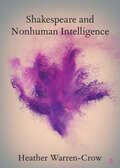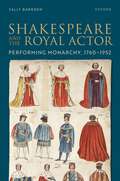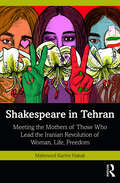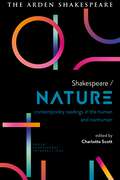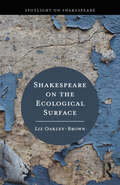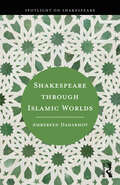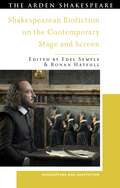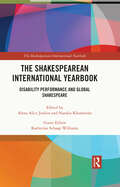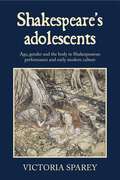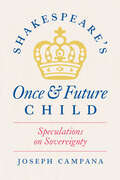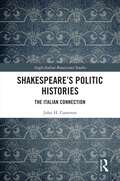- Table View
- List View
Shakespeare and: The Merry Wives of Windsor (ISSN)
by Elizabeth SchaferSeismic shifts in the theatrical meanings of The Merry Wives of Windsor have taken place across the centuries as Shakespeare’s frequently performed play has relocated to Windsor across the world, journeying along the production/adaptation/appropriation continuum.This (eco-)performance history of Shakespeare’s The Merry Wives of Windsor not only offers the first in-depth analysis of the play in production, with a particular focus on the representation of merry women, but also utilises the comedy’s forest-aware dramaturgy to explore Mistress Page’s concept of being ‘frugal in my mirth’ in relation to sustainable theatre practices. Herne’s Oak – the fictitious tree in Windsor Forest where everyone meets in the final scene of the play – is utilised to enable a maverick but ecologically based reframing of the productions of Merry Wives analysed here.This study engages with gender, physical comedy, and cultural relocations of Windsor across the world to offer new insight into Merry Wives and its theatricality.
Shakespeare and Lecoq: A Practical Guide for Actors, Directors, Students and Teachers (Arden Performance Companions)
by Dr Abigail Rokison-Woodall Ed WoodallThis book provides actors, directors, teachers and students with a clear, practical guide to applying the work of influential theatre practitioner Jacques Lecoq to the process of rehearsing or workshopping the Shakespeare text. Written by theatre practitioner Ed Woodall, who trained with Lecoq himself, and Shakespeare academic Abigail Rokison-Woodall, this guide begins with warm-ups and ensemble-building, and moves through explorations of the story, the world of the play, the text, character emotion, thought and physicality and staging. Lecoq's method often relies on 'play', and play is often seen as trivial or inconsequential. This book argues that the more playful you are, the more playfully you investigate your speech or scene and the more physically motivated that playfulness is, the more vital and lifelike your acting of Shakespeare will be.
Shakespeare and Nonhuman Intelligence (Elements in Shakespeare Performance)
by null Heather Warren-CrowThe Infinite Monkey Theorem is an idea frequently encountered in mass market science books, discourse on Intelligent Design, and debates on the merits of writing produced by chatbots. According to the Theorem, an infinite number of typing monkeys will eventually generate the works of Shakespeare. Shakespeare and Nonhuman Intelligence is a metaphysical analysis of the Bard's function in the Theorem in various contexts over the past century. Beginning with early-twentieth century astrophysics and ending with twenty-first century AI, it traces the emergence of Shakespeare as the embattled figure of writing in the age of machine learning, bioinformatics, and other alleged crimes against the human organism. In an argument that pays close attention to computer programs that instantiate the Theorem, including one by biologist Richard Dawkins, and to references in publications on Intelligent Design, it contends that Shakespeare performs as an interface between the human and our Others: animal, god, machine.
Shakespeare and the Political: Elizabethan Politics and Asian Exigencies
by Rita Banerjee and Yilin ChenShakespeare and the Political: Elizabethan Politics and Asian Exigencies is a collection of essays which show how selected Shakespearean plays and later adaptations engage with the political situations of the Elizabethan period as well as contemporary Asian societies. The various interpretations of the original plays focus on the institutions of family and honour, patriarchy, kingship and dynasty, and the emergent ideologies of the nation and cosmopolitanism, adopting a variety of approaches like historicism, presentism, psychoanalysis, feminism and close reading.The volume also looks at Shakespearean adaptations in Asia – Taiwanese, Japanese, Chinese and Indian. Using Douglas Lanier's concept of the 'rhizomatic' approach, it seeks to examine how Asian Shakespearean adaptations, films and stage performances, appropriate and reproduce originals often 'unfaithfully' in different social and temporal contexts to produce independent works of art.
Shakespeare and the Royal Actor: Performing Monarchy, 1760-1952
by Sally BarndenShakespeare and the Royal Actor argues that members of the royal family have identified with Shakespearean figures at various times in modern history to assert the continuity, legitimacy, and national identity of the royal line. It provides an account of the relationship between the Shakespearean afterlife and the royal family through the lens of a broadly conceived theatre history suggesting that these two hegemonic institutions had a mutually sustaining relationship from the accession of George III in 1760 to that of Elizabeth II in 1952. Identifications with Shakespearean figures have been deployed to assert the Englishness of a dynasty with strong familial links to Germany and to cultivate a sense of continuity from the more autocratic Plantagenet, Tudor, and Stuart monarchs informing Shakespeare's drama to the increasingly ceremonial monarchs of the modern period. The book is driven by new archival research in the Royal Collection and Royal Archives. It reads these archives critically, asking how different forms of royal and Shakespearean performance are remembered in the material holdings of royal institutions.
Shakespeare in Tehran: Meeting the Mothers of Those Who Lead the Iranian Revolution of Woman, Life, Freedom
by Mahmood Karimi HakakShakespeare in Tehran is a personal history of Iran through the eyes of an award-winning Iranian American artist. Drawing on parallels between life and the stage, it uses A Midsummer Night’s Dream as a roadmap to explore social, political, economic, and cultural aspects of Iran before and after the revolution of 1979. Through first-person accounts, interspersed with emotional reflections of the universal human experience, it delves into the historical and sociological context of a divided country. Storytelling, flashbacks, and flashforwards paint an intimate picture of public life in Iran in a time of uncertainty. Accessible, engaging, and nuanced, this volume will be of interest to scholars and researchers of politics, history, theater and performance studies, and West Asian studies.
Shakespeare in Tehran: Meeting the Mothers of Those Who Lead the Iranian Revolution of Woman, Life, Freedom
by Mahmood Karimi HakakShakespeare in Tehran is a personal history of Iran through the eyes of an award-winning Iranian American artist. Drawing on parallels between life and the stage, it uses A Midsummer Night’s Dream as a roadmap to explore social, political, economic, and cultural aspects of Iran before and after the revolution of 1979. Through first-person accounts, interspersed with emotional reflections of the universal human experience, it delves into the historical and sociological context of a divided country. Storytelling, flashbacks, and flashforwards paint an intimate picture of public life in Iran in a time of uncertainty. Accessible, engaging, and nuanced, this volume will be of interest to scholars and researchers of politics, history, theater and performance studies, and West Asian studies.
Shakespeare in the Theatre: The Stratford Festival (Shakespeare in the Theatre)
by Dr Christie CarsonThis analysis of the Stratford Festival examines the full history of one of the largest and oldest dedicated centres for the performance of Shakespeare in North America. In English-speaking Canada, the Festival has become the unofficial national theatre, drawing both praise and criticism. Dividing its history into three distinct periods, the volume begins with the foundation of the company, moving through its middle years of expansion and securing stability, and ending with an exploration of staging Shakespeare in the 21st century. Through case studies of productions, covering each artistic director from Tyrone Guthrie to Antoni Cimolino, it highlights issues of national identity but also the relationship between actor and audience on the Festival's unique thrust stage. It not only explores the work of international stars such as Christopher Plummer, but also that of longstanding company members William Hutt and Martha Henry, emphasizing the Festival's collective spirit. This book argues that the Stratford Festival holds an influential position in the theatre world generally and in the Shakespeare performance environment specifically. Initially this was because of the original stage built for its opening, but increasingly it has been due to the way that it has used Shakespeare's work to articulate complex questions about identity and utilized technology to reach new audiences. The Festival and its collaborative working methods grew out of a particular social and political climate, and when the actors and directors who trained at the Festival took their training and its influences elsewhere, they spread its impact.
Shakespeare in the Theatre: Tina Packer (Shakespeare in the Theatre)
by Katharine GoodlandThis book examines the work of acclaimed director Tina Packer, founder of Shakespeare & Company, whose ground-breaking approach to performing Shakespeare has made her company among the most vibrant and enduring Shakespeare theatres in America. Tina Packer directed her first Shakespeare play at London Academy for Music and Dramatic Art in 1971. More than 50 years later she continues to direct and teach at Shakespeare & Company, which she founded in Lenox, Massachusetts in 1978. Drawing on new interviews with the original casts and creative teams as well as Tina Packer herself, this book is the first comprehensive analysis of all of her professional Shakespeare productions in their cultural and historical context. Over a career that spans 5 decades, Packer has directed or acted in virtually all of Shakespeare's plays, along with many other classical and contemporary works. As artistic director she guided her company through times of expansion as well as belt-tightening, driven by her conviction that the purpose of theatre is to heal and that to fulfil that purpose, acting must tell the truth. With in-depth case studies of 12 of her most significant productions, Katharine Goodland offers a clear account of Packer's work and contribution to Shakespearean theatre in America while illuminating the embedded nature of regional Shakespeare in communities across the United States.
Shakespeare is Hard, but so is Life
by Fintan O'TooleThe works of Shakespeare have become staples of literature. They are everywhere, from our early schooling to the lecture rooms of academia, from classic theatre to modern adaptations on stage and screen. But how well do we really know his plays?In this witty, iconoclastic book, the bestselling author Fintan O'Toole examines four of Shakespeare's most enduring tragedies: Hamlet, Macbeth, Othello and King Lear. He shows how their tragic heroes have been over-simplified and moulded to fit restrictive, conservative values, and restores the true heart and spirit of the classics.'I've never read a book like this before: it's challenging, irreverent and funny.' Roddy Doyle
Shakespeare / Nature: Contemporary Readings in the Human and Non-human (Arden Shakespeare Intersections)
by Lucy Munro Professor Sonia Massai Dr Farah Karim Cooper Professor Gordon McMullanShakespeare / Nature sets new agendas for the study of nature in Shakespeare's work. Offering a rich exploration of the intersections between the human and non-human worlds, the chapters focus on the contested and persuasive language of nature, both as organic matter and cultural conditioning.Rooted in close textual analysis and historical acuity, this collection addresses Shakespeare's works through the many ways in which 'nature' performs, as a cultural category, a moral marker and a set of essential conditions through which the human may pass, as well as affect. Addressing the complex conditions of the play worlds, the chapters explore the assorted forms through which Shakespeare's nature makes sense of its narratives and supports, upholds or contests its story-telling. Over the course of the collection, the contributors examine plays including Macbeth, Julius Caesar, The Tempest, The Taming of the Shrew, Othello, Love's Labour's Lost, Hamlet, Timon of Athens and many more. They discuss them through the various lenses of philosophy, historicism, psychoanalysis, gender studies, cosmography, geography, sexuality, linguistics, environmentalism, feminism and robotics, to provide new and nuanced readings of the intersectional terms of both meaning and matter.Approaching 'nature' in all its multiplicity, this collection sets out to examine the divergent and complex ways in which the human and non-human worlds intersect and the development of a language of symbiosis that attempts to both control and create the terms of human authority. It offers an entirely new approach to the subject of nature, bringing together disparate methods that have previously been pursued independently to offer a shared investment in the intersections between the human and non-human worlds and how these discourses shape and condition the emotional, organic, cultural and psychological landscapes of Shakespeare's play worlds.
Shakespeare on the Ecological Surface (Spotlight on Shakespeare)
by Liz Oakley-BrownShakespeare on the Ecological Surface uses the concept of the ‘surface’ to examine the relationship between contemporary performance and ecocriticism. Each section looks, in turn, at the 'surfaces' of slick, smoke, sky, steam, soil, slime, snail, silk, skin and stage to build connections between ecocriticism, activism, critical theory, Shakespeare and performance. While the word ‘surface’ was never used in Shakespeare’s works, Liz Oakley-Brown shows how thinking about Shakespearean surfaces helps readers explore the politics of Elizabethan and Jacobean culture. She also draws surprising parallels with our current political and ecological concerns. The book explores how Shakespeare uses ecological surfaces to help understand other types of surfaces in his plays and poems: characters’ public-facing selves; contact zones between characters and the natural world; surfaces upon which words are written; and physical surfaces upon which plays are staged. This book will be an illuminating read for anyone studying Shakespeare, early modern culture, ecocriticism, performance and activism.
Shakespeare on the Ecological Surface (Spotlight on Shakespeare)
by Liz Oakley-BrownShakespeare on the Ecological Surface uses the concept of the ‘surface’ to examine the relationship between contemporary performance and ecocriticism. Each section looks, in turn, at the 'surfaces' of slick, smoke, sky, steam, soil, slime, snail, silk, skin and stage to build connections between ecocriticism, activism, critical theory, Shakespeare and performance. While the word ‘surface’ was never used in Shakespeare’s works, Liz Oakley-Brown shows how thinking about Shakespearean surfaces helps readers explore the politics of Elizabethan and Jacobean culture. She also draws surprising parallels with our current political and ecological concerns. The book explores how Shakespeare uses ecological surfaces to help understand other types of surfaces in his plays and poems: characters’ public-facing selves; contact zones between characters and the natural world; surfaces upon which words are written; and physical surfaces upon which plays are staged. This book will be an illuminating read for anyone studying Shakespeare, early modern culture, ecocriticism, performance and activism.
Shakespeare through Islamic Worlds (Spotlight on Shakespeare)
by Ambereen DadabhoyShakespeare through Islamic Worlds investigates the peculiar absence of Islam and Muslims from Shakespeare’s canon. While many of Shakespeare’s plays were set in the Mediterranean, a geography occupied by Muslim empires and cultures, his work eschews direct engagement with the religion and its people. This erasure is striking given the popularity of this topic in the plays of Shakespeare’s contemporaries. By exploring the limited ways in which Shakespeare uses Islamic and Muslim tropes and topoi, Ambereen Dadabhoy argues that Islam and Muslim cultures function as an alternate or shadow text in his works, ranging from his staged Mediterranean plays to his histories and comedies. By consigning the diverse cultures of the Islamic regimes that occupied and populated the early modern Mediterranean, Shakespeare constructs a Europe and Mediterranean freed from the presence of non-white, non-European, and non-Christian Others, which belied the reality of the world in which he lived. Focusing on the Muslims at the margins of Shakespeare’s works, Dadabhoy reveals that Islam and its cultures informed the plots, themes, and intellectual investments of Shakespeare’s plays. She puts Islam and Muslims back into the geographies and stories from which Shakespeare had evacuated them. This innovative book will be of interest to all those working on race, religion, global and cultural exchange within Shakespeare, as well as people working on Islamic, Mediterranean, and Asian studies in literature and the early modern period.
Shakespeare through Islamic Worlds (Spotlight on Shakespeare)
by Ambereen DadabhoyShakespeare through Islamic Worlds investigates the peculiar absence of Islam and Muslims from Shakespeare’s canon. While many of Shakespeare’s plays were set in the Mediterranean, a geography occupied by Muslim empires and cultures, his work eschews direct engagement with the religion and its people. This erasure is striking given the popularity of this topic in the plays of Shakespeare’s contemporaries. By exploring the limited ways in which Shakespeare uses Islamic and Muslim tropes and topoi, Ambereen Dadabhoy argues that Islam and Muslim cultures function as an alternate or shadow text in his works, ranging from his staged Mediterranean plays to his histories and comedies. By consigning the diverse cultures of the Islamic regimes that occupied and populated the early modern Mediterranean, Shakespeare constructs a Europe and Mediterranean freed from the presence of non-white, non-European, and non-Christian Others, which belied the reality of the world in which he lived. Focusing on the Muslims at the margins of Shakespeare’s works, Dadabhoy reveals that Islam and its cultures informed the plots, themes, and intellectual investments of Shakespeare’s plays. She puts Islam and Muslims back into the geographies and stories from which Shakespeare had evacuated them. This innovative book will be of interest to all those working on race, religion, global and cultural exchange within Shakespeare, as well as people working on Islamic, Mediterranean, and Asian studies in literature and the early modern period.
Shakespearean Biofiction on the Contemporary Stage and Screen (Shakespeare and Adaptation)
by Professor Mark Thornton BurnettThis book is the first edited collection to explore Shakespeare's life as depicted on the modern stage and screen. Focusing on the years 1998-2023, it uniquely identifies a 25-year trend for depicting Shakespeare, his family and his social circle in theatre, film and television. Interrogating Shakespeare's afterlife across stage and screen media, the volume explores continuities and changes in the form since the release of Shakespeare in Love, which it positions as the progenitor of recent Shakespearean biofictions in Anglo-American culture. It traces these developments through the 21st century, from pivotal moments such as the Shakespeare 400 celebrations in 2016, up to the quatercentenary of the publication of the First Folio, whose portrait helped make the author a globally recognisable icon. The collection takes account of recent Anglo-American socio-political, cultural and literary concerns including feminism, digital media and the biopic and superhero genres. The wide variety of works discussed range from All is True and Hamnet to Upstart Crow, Bill and even The Lego Movie. Offering insights from actors, dramatists and literary and performance scholars, it considers why artists are drawn to Shakespeare as a character and how theatre and screen media mediate his status as literary genius.
The Shakespearean International Yearbook: Disability Performance and Global Shakespeare (The Shakespearean International Yearbook)
by Alexa Alice Joubin Natalia Khomenko Katherine Schaap WilliamsThe Shakespearean International Yearbook surveys the present state of Shakespeare studies in global contexts, addressing issues that are fundamental to our interpretive encounter with Shakespeare’s work and his time. Contributions are solicited from scholars across the field and from both hemispheres of the globe who represent diverse career stages and linguistic traditions. Both new and ongoing trends are examined in comparative contexts, and emerging voices in different cultural contexts are featured alongside established scholarship. Each volume features a collection of articles that focus on a theme curated by a specialist Guest Editor, along with coverage of the current state of the field in other aspects. An essential reference tool for scholars of early modern literature and culture, this annual publication captures, from year to year, current and developing thought in global Shakespeare scholarship and performance practice worldwide.
The Shakespearean International Yearbook: Disability Performance and Global Shakespeare (The Shakespearean International Yearbook)
by Alexa Alice Joubin Natalia Khomenko Katherine Schaap WilliamsThe Shakespearean International Yearbook surveys the present state of Shakespeare studies in global contexts, addressing issues that are fundamental to our interpretive encounter with Shakespeare’s work and his time. Contributions are solicited from scholars across the field and from both hemispheres of the globe who represent diverse career stages and linguistic traditions. Both new and ongoing trends are examined in comparative contexts, and emerging voices in different cultural contexts are featured alongside established scholarship. Each volume features a collection of articles that focus on a theme curated by a specialist Guest Editor, along with coverage of the current state of the field in other aspects. An essential reference tool for scholars of early modern literature and culture, this annual publication captures, from year to year, current and developing thought in global Shakespeare scholarship and performance practice worldwide.
Shakespeare's adolescents: Age, gender and the body in Shakespearean performance and early modern culture
by Victoria SpareyShakespeare’s adolescents examines the varied representation of adolescent characters in Shakespeare’s plays. Using early modern medical knowledge and an understanding of contemporary theatrical practices, the book unpacks complexities that surrounded the cultural and theatrical representations of ‘signs’ associated with an individual’s physical maturation. Each chapter explores the implications of different ‘signs’ of puberty, in verbal cues, facial adornments, vocal traits and body sizes, to illuminate how Shakespeare presents vibrant adolescent selves and stories.By analysing female and male puberty together in its discussion of adolescence, Shakespeare’s adolescents provides fresh insight into the age-based symmetry of early modern adolescent identities. The book uses the adolescent’s state of transformation to illuminate how the unfixed nature of adolescence was valued in early modern culture and through Shakespeare’s celebrated characters and actors.
Shakespeare's adolescents: Age, gender and the body in Shakespearean performance and early modern culture
by Victoria SpareyShakespeare’s adolescents examines the varied representation of adolescent characters in Shakespeare’s plays. Using early modern medical knowledge and an understanding of contemporary theatrical practices, the book unpacks complexities that surrounded the cultural and theatrical representations of ‘signs’ associated with an individual’s physical maturation. Each chapter explores the implications of different ‘signs’ of puberty, in verbal cues, facial adornments, vocal traits and body sizes, to illuminate how Shakespeare presents vibrant adolescent selves and stories.By analysing female and male puberty together in its discussion of adolescence, Shakespeare’s adolescents provides fresh insight into the age-based symmetry of early modern adolescent identities. The book uses the adolescent’s state of transformation to illuminate how the unfixed nature of adolescence was valued in early modern culture and through Shakespeare’s celebrated characters and actors.
Shakespeare's book: Essays in reading, writing and reception
by Richard Wilson Jane Rickard Richard MeekThis collection of essays is part of a new phase in Shakespeare studies. The traditional view of Shakespeare is that he was a man of the theatre who showed no interest in the printing of his plays, producing works that are only fully realised in performance. This view has recently been challenged by critics arguing that Shakespeare was a literary ‘poet-playwright’, concerned with his readers as well as his audiences. Shakespeare’s Book offers a vital contribution to this critical debate, and examines its wider implications for how we conceive of Shakespeare and his works. Bringing together an impressive group of international Shakespeare scholars, the volume explores both Shakespeare’s relationship with actual printers, patrons, and readers, and the representation of writing, reading, and print within his works themselves.
Shakespeare's Once and Future Child: Speculations on Sovereignty
by Joseph CampanaA study of Shakespeare’s child figures in relation to their own political moment, as well as our own. Politicians are fond of saying that “children are the future.” How did the child become a figure for our political hopes? Joseph Campana’s book locates the source of this idea in transformations of childhood and political sovereignty during the age of Shakespeare, changes spectacularly dramatized by the playwright himself. Shakespeare’s works feature far more child figures—and more politically entangled children—than other literary or theatrical works of the era. Campana delves into this rich corpus to show how children and childhood expose assumptions about the shape of an ideal polity, the nature of citizenship, the growing importance of population and demographics, and the question of what is or is not human. As our ability to imagine viable futures on our planet feels ever more limited, and as children take up legal proceedings to sue on behalf of the future, it behooves us to understand the way past child figures haunt our conversations about intergenerational justice. Shakespeare offers critical precedents for questions we still struggle to answer.
Shakespeare's Once and Future Child: Speculations on Sovereignty
by Joseph CampanaA study of Shakespeare’s child figures in relation to their own political moment, as well as our own. Politicians are fond of saying that “children are the future.” How did the child become a figure for our political hopes? Joseph Campana’s book locates the source of this idea in transformations of childhood and political sovereignty during the age of Shakespeare, changes spectacularly dramatized by the playwright himself. Shakespeare’s works feature far more child figures—and more politically entangled children—than other literary or theatrical works of the era. Campana delves into this rich corpus to show how children and childhood expose assumptions about the shape of an ideal polity, the nature of citizenship, the growing importance of population and demographics, and the question of what is or is not human. As our ability to imagine viable futures on our planet feels ever more limited, and as children take up legal proceedings to sue on behalf of the future, it behooves us to understand the way past child figures haunt our conversations about intergenerational justice. Shakespeare offers critical precedents for questions we still struggle to answer.
Shakespeare’s Politic Histories: The Italian Connection (Anglo-Italian Renaissance Studies)
by John H. CameronThis book argues that Shakespeare's first tetralogy is informed by the Italian ‘politic histories’ of the early modern period, those works of history, inspired by the Roman historian Tacitus, that sought to explore the machinations of power politics in governance and in the shaping of historical events; that a close reading of these Italian ‘politic histories’ will greatly aid our understanding of the ‘politic’ qualities dramatized in Shakespeare’s early English History plays; that the writings of Niccolò Machiavelli in particular will likewise aid to such understanding; that these ‘politic histories’ were available (in a variety of forms) to many English early modern writers, Shakespeare included, and are thus helpful as grounds for political and strategic analogy and for informing our reading of Shakespeare's politic histories. While a reading of the Italian ‘politic’ historians can aid in our understanding of Shakespeare’s achievement, we should regard the English History plays as ‘politic histories’ in their own right, i.e. as dramatized versions of precisely the same kinds of ‘politic’ historical writing, with its emphasis on ragion di Stato or raison d’état. This emphasis on what the Elizabethans called ‘stratagems’ suggests new ways to read the plays and to interpret the motivation and action of its characters, ways that challenge some of our more established reading of the plays’ ‘Machiavellian’ characters (particularly Richard III) and suggest far greater strategic acumen on the part of previously overlooked characters (particularly Buckingham and Stanley), providing new ways to read the Shakespeare's politic histories and to better appreciate their Italian connection.
Shakespeare’s Politic Histories: The Italian Connection (Anglo-Italian Renaissance Studies)
by John H. CameronThis book argues that Shakespeare's first tetralogy is informed by the Italian ‘politic histories’ of the early modern period, those works of history, inspired by the Roman historian Tacitus, that sought to explore the machinations of power politics in governance and in the shaping of historical events; that a close reading of these Italian ‘politic histories’ will greatly aid our understanding of the ‘politic’ qualities dramatized in Shakespeare’s early English History plays; that the writings of Niccolò Machiavelli in particular will likewise aid to such understanding; that these ‘politic histories’ were available (in a variety of forms) to many English early modern writers, Shakespeare included, and are thus helpful as grounds for political and strategic analogy and for informing our reading of Shakespeare's politic histories. While a reading of the Italian ‘politic’ historians can aid in our understanding of Shakespeare’s achievement, we should regard the English History plays as ‘politic histories’ in their own right, i.e. as dramatized versions of precisely the same kinds of ‘politic’ historical writing, with its emphasis on ragion di Stato or raison d’état. This emphasis on what the Elizabethans called ‘stratagems’ suggests new ways to read the plays and to interpret the motivation and action of its characters, ways that challenge some of our more established reading of the plays’ ‘Machiavellian’ characters (particularly Richard III) and suggest far greater strategic acumen on the part of previously overlooked characters (particularly Buckingham and Stanley), providing new ways to read the Shakespeare's politic histories and to better appreciate their Italian connection.


